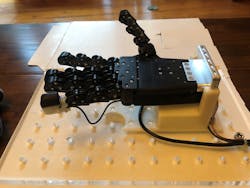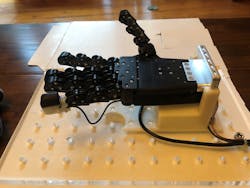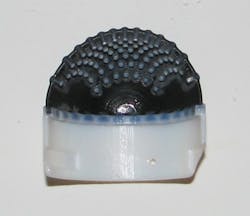At Your Fingertips: Improving Dexterity Through 3D-Printed Skin
The field of soft robotics has a longstanding relationship with healthcare. When it comes to emulating the sense of touch, however, researchers have had limited success fine-tuning dexterity and tactile-sensing technology.
In an experimental study, scientists have made an in-depth comparison of an artificial fingertip with neural recordings of the human sense of touch. The findings, published in two papers in the Journal of the Royal Society Interface, describe the creation of an artificial biomimetic tactile sensor (the TacTip), which could provide artificial analogs of human skin dynamics and afferent responses. Simply stated, the artificial fingertip can mimic human nerve signals.
The researchers, who hail from the University of Bristol’s Department of Engineering Maths and are based at the Bristol Robotics Laboratory, created the artificial sense of touch using a 3D-printed mesh of papillae on the underside of the compliant skin. The construction is reminiscent of the skin’s dermal-epidermal interface backed by a mesh of “biomimetic intermediate ridges and dermal papillae, comprising inner pins tipped with markers,” noted the researchers.
The papillae were constructed on advanced 3D printers capable of missing soft and hard materials that emulate textures and effects found in human biology.
“Our work helps uncover how the complex internal structure of human skin creates our human sense of touch,” reported lead researcher Nathan Lepora, professor of robotics and AI. “This is an exciting development in the field of soft robotics—being able to 3D print tactile skin could create robots that are more dexterous or significantly improve the performance of prosthetic hands by giving them an in-built sense of touch.”
The University of Bristol noted that a 3D-printed tactile fingertip can produce artificial nerve signals that look like recordings from real, tactile neurons. “Human tactile nerves transmit signals from various nerve endings called mechanoreceptors, which can signal the pressure and shape of a contact,” said Lepora. “Classic work by Phillips and Johnson in 1981 first plotted electrical recordings from these nerves to study ‘tactile spatial resolution’ using a set of standard ridged shapes used by psychologists. In our work, we tested our 3D-printed artificial fingertip as it ‘felt’ those same ridged shapes and discovered a startlingly close match to the neural data.
“For me, the most exciting moment was when we looked at our artificial nerve recordings from the 3D-printed fingertip and they looked like the real recordings from over 40 years ago. Those recordings are very complex, with hills and dips over edges and ridges, and we saw the same pattern in our artificial tactile data.”
One area that needs refinement, according to the researchers, is the artificial fingertip’s sensitivity to fine detail. Lepora noted that the 3D-printed skin is thicker than real skin and and his team is exploring how to 3D print structures on the microscopic scale of human skin.
“Our aim is to make artificial skin as good—or even better—than real skin,” he said.
Papers
- “Artificial SA-I, RA-I and RA-II/vibrotactile afferents for tactile sensing of texture,” by Pestell, N. & Lepora, N. in Journal of the Royal Society Interface. DOI: 10.1098/rsif.2021.0603.
- “Artificial SA-I and RA-I afferents for tactile sensing of ridges and gratings,” by Pestell, N., Griffith, T. and Lepora, N. in Journal of the Royal Society Interface. DOI: 10.1098/rsif.2021.0822.
About the Author

Rehana Begg
Editor-in-Chief, Machine Design
As Machine Design’s content lead, Rehana Begg is tasked with elevating the voice of the design and multi-disciplinary engineer in the face of digital transformation and engineering innovation. Begg has more than 24 years of editorial experience and has spent the past decade in the trenches of industrial manufacturing, focusing on new technologies, manufacturing innovation and business. Her B2B career has taken her from corporate boardrooms to plant floors and underground mining stopes, covering everything from automation & IIoT, robotics, mechanical design and additive manufacturing to plant operations, maintenance, reliability and continuous improvement. Begg holds an MBA, a Master of Journalism degree, and a BA (Hons.) in Political Science. She is committed to lifelong learning and feeds her passion for innovation in publishing, transparent science and clear communication by attending relevant conferences and seminars/workshops.
Follow Rehana Begg via the following social media handles:
X: @rehanabegg
LinkedIn: @rehanabegg and @MachineDesign


